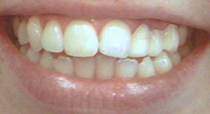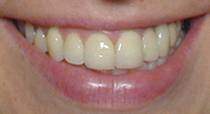By Arthur Kezian
Dental veneers are a beautiful way to correct stained, chipped, or crooked teeth. By placing glass-like ceramic porcelain on the surface of teeth, dentists can provide patients with bright, straight, and natural looking smiles. If you are considering veneers but would like more information about the process of placing porcelain veneers and the cost of treatment, please read the information below.
Porcelain veneers are thin shells of porcelain that are bonded onto the front side of teeth to create a cosmetic improvement for a tooth. They are routinely used as a way to make cosmetic changes for teeth that are discolored, worn, chipped, or misaligned.
Porcelain veneers have a great advantage over other cosmetic bonding techniques because they are translucent and when bonded onto a tooth’s surface they will closely mimic the light handling characteristics of dental enamel. Dental crowns typically encase an entire tooth whereas porcelain veneers only cover over the front side of a tooth.
 |
 |
| Before | After |
How do veneers differ from dental crowns?
In comparison to a dental crown, the classic porcelain veneer is a wafer thin shell of ceramic that is bonded onto the front side of a tooth. Whereas a dental crown covers over and encases the entire tooth, a porcelain veneer just covers over the side of the tooth that shows when the person smiles. Dental crowns and porcelain veneers also differ by way of their relative thickness. The classic porcelain veneer will measure 1 millimeter in thickness or less, as opposed to a dental crown that typically measures 2mm. Here are some of the factors determine which type of dental restoration would be the more ideal choice.
Dental Crowns:
- Can be used to produce significant color and shape changes for a tooth.
- Are often used to rebuild teeth that are badly broken or decayed.
- Are very strong. Dental crowns are a good choice in those situations where the tooth is subject to significant chewing and biting forces or else tooth clenching and grinding (bruxism).
- Require a significant amount of tooth reduction when made.
- Once a crown has been made for a tooth the tooth will always require a dental crown.
Porcelain Veneers:
- Can be used to produce significant color and minor shape changes for a tooth.
- Are placed on teeth whose underlying tooth structure is generally healthy and intact.
- Are strong but brittle. Porcelain veneers typically do best in those situations where the biting forces they are subject to are somewhat passive.
- Typically require much less tooth reduction than dental crowns.
- For all practical purposes, once a porcelain veneer has been made for a tooth it’s irreversible.
What Will My Porcelain Veneers Look Like?
The glass-like ceramic that forms porcelain veneers closely resembles natural tooth enamel because, much like real tooth enamel they are translucent. This translucent effect is what gives teeth their luster. By replicating this, a cosmetic dentist in Los Angeles can provide patients with bright, natural looking smiles.
Porcelain dental veneers can also cover and repair cracked and chipped teeth. Because crowns are custom made and fitted to your teeth by a skilled dentist, you can customize and improve much more than just the color of your teeth. Crooked and chipped teeth can have their appearances improved to give you a beautiful new smile and can be color matched to your natural teeth.
Porcelain veneers generally cost from $1,000 to $1,200 per tooth. When considering the cost of porcelain veneers, you must take into account their longevity and attractiveness. Porcelain veneers are long lasting alternatives to other treatments that cost less but must be repaired frequently.
For more information about porcelain veneers, or any other dental related topics, feel free to contact us by visiting our website or by calling our office.
Dr. Arthur A. Kezian DDS 443 N. Larchmont Blvd Los Angeles, CA 90004 (323) 467-2777
